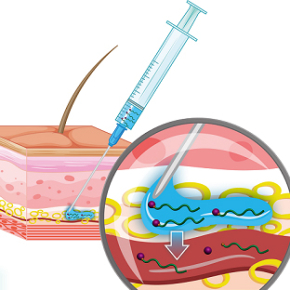
Chemotherapy: towards a simplified subcutaneous administration
The treatment of cancer is often based on intravenous chemotherapy, which is highly demanding and requires hospitalisation. One of the possibilities considered to alleviate this protocol is subcutaneous chemotherapy. Though much simpler to implement and more comfortable for the patient, it is impossible to practice as most of the active ingredients administered are irritant and vesicant ‒ they stagnate in the subcutaneous tissue where they cause skin necrosis due to their high toxicity.
To circumvent this obstacle, scientists1 have developed a new approach for an active ingredient widely used in chemotherapy, paclitaxel. By coupling it to a polymer with a high affinity for water, they have succeeded in obtaining a soluble anticancer agent that can be rapidly transferred from the subcutaneous tissue to the bloodstream without causing toxicity in the skin.
In fact, during the preclinical development of this new drug in mice, scientists were able to obtain a better efficacy than with the commercial formulation of the active ingredient administered intravenously. This new research, published in the Journal of the American Chemical Society, could represent an important step towards the management of patients at home and even self-administrated chemotherapy.
- 11 The scientists involved in this study are from : the Institut Galien Paris-Saclay (CNRS/Université Paris-Saclay), the Département médicaments et technologies pour la santé (Université Paris-Saclay/CEA/INRAE) and the Département de biologie, pathologie et sciences de l’aliment (Oniris/Laboniris).
A Polymer Prodrug Strategy to Switch from Intravenous to Subcutaneous Cancer Therapy for Irritant/Vesicant Drugs, Alexandre Bordat, Tanguy Boissenot, Nada Ibrahim, Marianne Ferrere, Manon Levêque, Léa Potiron, Stéphanie Denis, Sébastien Garcia-Argote, Olivia Carvalho, Jérôme Abadie, Catherine Cailleau, Grégory Pieters, Nicolas Tsapis et Julien Nicolas, Journal of the American Chemical Society, 4th september 2022. DOI : 10.1021/jacs.2c04944


